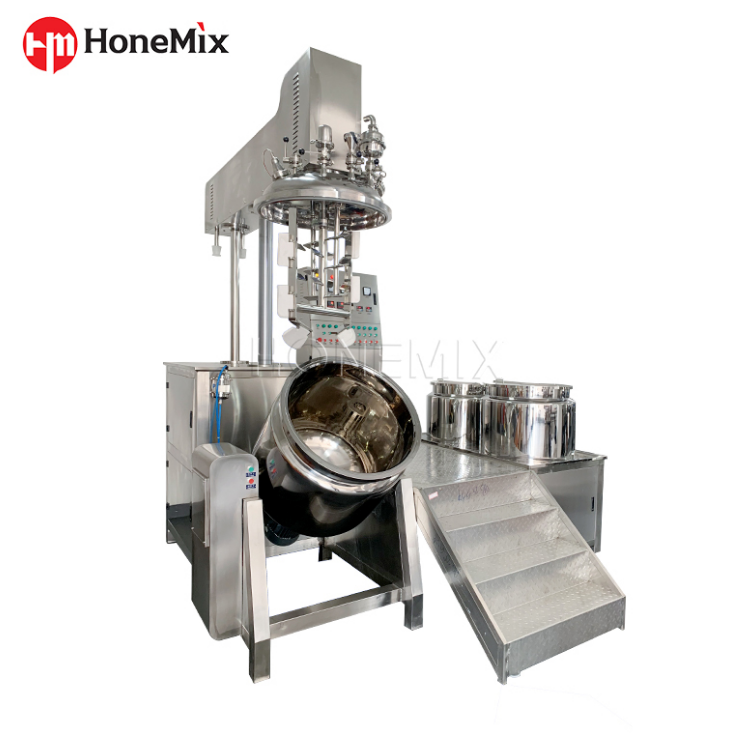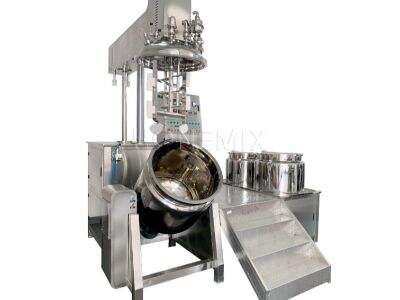Clearly you want a tour through how things are blended in the factory? Take lotions, face creams or even toothpaste for example when we produce products like those in mass scale (which hundreds of billions of tubes and jars are globally sold each year), it happens via big machines called vacuum emulsifying mixers and homogenizer mixer. These machines by HoneMix are very important in terms of mixing the ingredients properly and making sure that our end product comes out as good quality only.

What Are They Used For?
Most beauty products and medicines are made by vacuum emulsifying mixers as well, which use a higher force than Homogenizers. They are both high-powered machines that get the job done in which is to also blend all ingredients nicely. But they work somewhat differently and it is crucial to know how.
Vacuum emulsifying mixers suck the mixing vessel into vacuum. Effects: Reduces the air bubbles in cream and lotion, which is completely forbidden after that made smooth creams, lotions etc. These mixers can also stir the mixture in different speeds ranging from fast to slow speed mode as a continuum. This enables the mixing of ingredients more easily, depending on their nature.
On the other hand, homogenizers work differently. Therefore, the homogenizer machine do press the materials through tiny holes with a great deal of force. Through this process, the ingredients get crushed and mixed very well together. Though it is a powerful mixing process, there may be air bubbles incorporated in the product as well.
Which One Should You Use?
Where both machines are applicative in their own Vacuum emulsifying mixer may be the best choice if it is necessary to mix ingredients that should not have air bubbles because they could influence final product quality or consistency. It makes sure the mixture is consistent and prevents air bubbles.
But, if you have tougher materials that can handle being pushed through small holes without any trouble a homogenizer might be what works best for you. It provides quick mixing, and this is useful when there are loads of ingredients that need to be processed in a brief span.
Pros and Cons of Each Machine
After understanding the difference between vacuum emulsifying mixer and homogenizer, let us continue to see their own advantages and disadvantages.
Pros of Vacuum Emulsifying Mixer
Less air bubbles in the end product; no lumps, smoother.
Quality Uniformity in the product is basic for quality.
Adept at blending different kinds of ingredients together.
Cons of vacuum emulsifying mixer
The upfront cost may be higher than some other machines.
A Benford lights, flown at night can land some very shady types. Its another of those that needs a good operator to be effective.
Homogenizer Pros:
Has a higher mixing efficiency so time saving as well.
Great for making harder or tougher ingredients because the high pressure would settle.
Cost effective for mixing large quantities of a product which makes it well-suited to high-volume operations.
Homogenizer Cons:
Ingredients that do not like to be aerated: will ruin texture.
This would likely result on a less consistent product for use with many of the applications where AI is ideal.
Picking The Machine Right For You
But before you determine your go-to machine, there are a few things to consider. The very first thing you need to consider is which ingredients will be mixed together. Do they react to any air bubbles? Are you careful not to incorporate any air while mixing it? Also, please consider your budget, how much money you are ready to pay? Last but not least, some in advance thinking about the amount that you need to produce at a time. With these clear answers you will be more able to decide which device it plays better decided by your given circumstances.
Vacuum Emulsifying Mixers — Why use them?
Both of these machines have their strengths and issues, but vacuum emulsifying mixers provide a few unique advantages that may make them the best choice for most scenarios. They make products with lesser air bubbles, and that is critical if you are targeting for a product texture very smooth. In addition to this, they offer increased control over the mixing stages as well which is useful in guaranteeing that you product remains consistent and of a high quality. In addition, vacuum emulsifying mixers usually result in minimum mechanical force that is safer with rigorous compound than using high pressure; and it helps to keep the good quality of your products.
To sum up, choose a vacuum emulsifying mixer or homogenizer. Every machine has its own strength and weakness, so it is vital to choose what you need. No matter your choice has a consultation with an expert who can help guide you to properly use the machine so that you get great results from mixing.

 EN
EN
 AR
AR
 BG
BG
 HR
HR
 CS
CS
 DA
DA
 NL
NL
 FI
FI
 FR
FR
 DE
DE
 EL
EL
 IT
IT
 JA
JA
 KO
KO
 NO
NO
 PL
PL
 PT
PT
 RO
RO
 RU
RU
 ES
ES
 SV
SV
 TL
TL
 ID
ID
 LV
LV
 LT
LT
 SR
SR
 SL
SL
 VI
VI
 SQ
SQ
 HU
HU
 TH
TH
 TR
TR
 FA
FA
 MS
MS
 GA
GA
 BE
BE
 HY
HY
 BN
BN
 KK
KK
 UZ
UZ
